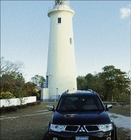ROAD TRIP - Lighthouse and homeward bound
Published: Sunday | March 8, 2009

Photo by Brian Carless
Japanese technology meets old-world charm.
Mario James, Gleaner Writer
We catch up on our nomadic islanders after breakfast. The sun is up and the glare off the white sand beach is intense, even in the morning! Colleen and Cecile are walking off the morning's gastronomical indulgences with Mario and Brian not far behind.
So we got our significant others and made for the beach. We had a ball!
The afternoon made its presence felt, and while there was stuff to do, we basically just took in the sights. As the shadows shortened and the heat started to lobsterise the tourists, we retired to our rooms for a little siesta, which turned into some serious shut-eye. In the bat of an eye it was 5 o'clock, and the sun started to make like Rembrandt with the sky. After hearing Carless wax poetic about the Negril Lighthouse, it seemed like a waste to come this far and not see it.
Search of history
So we bundled up in the Sport and went off in search of adventure and history; what we found was a little slice of heaven on an outcropping of well-maintained, grass-capped rock. And a little drama, too. The caretaker of the landmark - Wilson Johnson - has been the keep for 25 years. Run by the Port Authority of Jamaica, the lighthouse was commissioned in 1894 of a design done by the Trinity House - according to the Jamaica National Heritage Trust.
It was designed to sit on a tank of water with a depth of 14 feet and holding some 45,000 gallons of water - a feature brainstormed by French contractors Bubbler and Bernard. Because it actually 'floats' on water - the liquid acting as a shock absorber - it is said to be resistant to earthquake damage. The 66-foot tower can actually be felt to sway from time to time, Johnson says.
The trip to the edifice's barrel shaped, crystal 'greenhouse' was something else. Carless' better half, knowing what lay ahead, wisely decided to cop out. No amount of persuasion would change her mind - and we took little notice. But after being given a brief history by Johnson we started up some very ladder-like steps - 103 of them in all - that got steeper after every landing. The final flight was almost vertical, and while Johnson ran up them in goat-like fashion, for the uninitiated it was a task. At the very top we were greeted with a panoramic view that we would have enjoyed more if we didn't have to rub our quivering legs.
Beauty resplendent
After a few watershed moments, we went back to base - after being soundly laughed at by Cecile - calmed by the beauty resplendent on our little rock. So we spent our Saturday and our second, and final night, at Couples.
Our driving that day had depleted our diesel reserves; the gas gauge read quarter tank and it was clear that the return trip via the north coast would require more fuel. A little disappointing, for a diesel in this day and age - despite our high speed antics going to Negril.
Homeward bound - we started the journey after checking out, which made it about 12:30 p.m., your favourite photographer at the tiller, making best use of the cruise control. Through Ferris Cross, Bluefields, Font Hill - the Sport sitting on a strident 80km/h and doing a good job smoothing out the rough roads in that area.
Due North is the way I'll be travelling from now on - despite being longer and more twisty, the roads are pillow-like compared to this, so it's more efficient on time. At the foot of Spur Tree, we bought $2,000 worth of fuel - in all we bought 93 litres round trip - and then headed on in. Spur Tree was flattened by the big 3.2 - torque is what this engine delivers, and once the turbo is spooled up, it will waltz away from most anything in front of it.
Toll Road proved just how far the smaller cars have come - we ended up playing cat and mouse with a ProBox for much of the way in. The faster the Montero went, the more confidence-inspiring it got right up to naughty speeds.
In all we travelled 492 kilometres and consumed, based on the fuel gauge, one and one quarter tank of fuel, or 87.5 litres. The efficiency works out to 5.6 km/l, which works out to 17.7 litres per 100km - a bit on the thirsty side. But we did clog it on the way down, and there is a certain amount of fudge in these figures - gas gauges can be nefariously inaccurate. It is what it is.
All in all we had a ball! Can't wait until next year!
mario.james@gleanerjm.com
